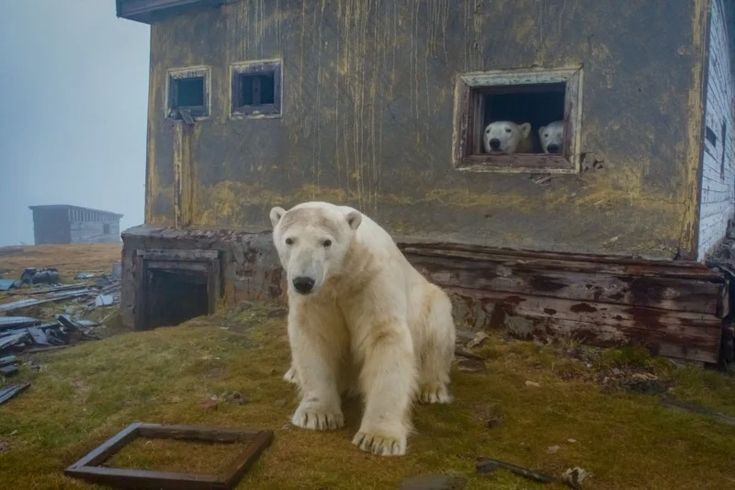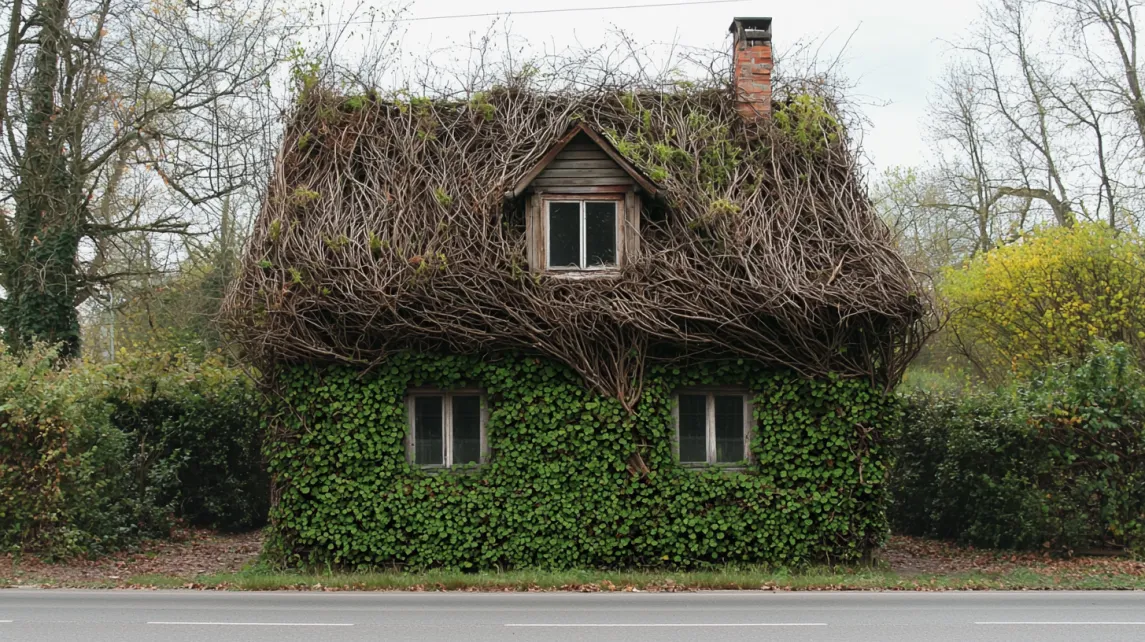Deep in the wilderness, where the hum of everyday life is replaced by the sounds of nature, an unlikely story unfolded that would forever change a remote village. The peaceful existence of its residents was suddenly disrupted—not by a storm, but by an astonishing visitor: two polar bears. These magnificent creatures, accustomed to the icy expanse of the Arctic, found themselves far from their usual habitat, taking refuge in an abandoned house nestled at the edge of the village. How and why did they end up there? This is the fascinating story of their unexpected journey.
The Quiet Village in the Wilderness
The village, tucked away in dense forests and rugged terrain, had always been a haven for those seeking peace away from the chaos of modern life. Surrounded by towering pines and thick underbrush, the few hundred residents lived simple, fulfilling lives. The village was a place where nature was in charge, and the community rarely saw visitors—just the occasional traveler or wildlife photographer. However, the peace would soon be shattered by a pair of unexpected guests.
At the edge of the village stood an old, decaying house. Its paint had long peeled away, and the garden had been overtaken by wild plants. It was a forgotten relic, its history unknown to the villagers, yet it had become a fixture of the landscape—no one paid much attention to it. That is, until two polar bears decided to make it their home.
A Surprising Arrival
It all began when a group of hunters spotted the bears from a distance, wandering close to the old house. At first, they thought they were imagining things—polar bears didn’t belong here. The village was nowhere near the icy realm of the Arctic, and no one had ever seen these majestic creatures in the wild before. But as the days passed, the bears made their way toward the abandoned house, settling inside, much to the alarm of the locals.
News of the strange occurrence spread quickly. While the villagers had encountered wolves, deer, and even mountain lions, the sight of polar bears—far from their northern homes—was a cause for both confusion and fear. These wild, powerful creatures were not only a rare sight but a serious threat to the safety of the village.
David Chish: The Wildlife Biologist Called to the Rescue
When David Chish, a wildlife biologist with expertise in animal behavior, received the call, he was skeptical. How could polar bears end up in a village so far from their natural habitat? But driven by his passion for wildlife and his need for answers, David embarked on the long journey to the remote village. Upon arriving, he was struck by the villagers’ reaction—rather than panic, there was a sense of bewilderment. No one could explain why the bears had chosen this particular spot.
David quickly got to work, talking to the locals to gather any clues. It appeared the bears had arrived out of nowhere, wandering the outskirts of the village before taking refuge in the old house. The villagers assumed they were lost or disoriented, but David knew something deeper was at play.
The Mystery of the Abandoned House
As David examined the abandoned house from a distance, the eerie quietness of the situation struck him. The villagers had set up a rudimentary barricade around the property to keep people safe, but the bears weren’t leaving. They had made this decrepit home their refuge, and it was clear they weren’t just passing through.
David knew that if he was going to uncover the reason behind the bears’ unusual behavior, he would need to approach them—something that required careful planning. Polar bears, though seemingly calm, could turn aggressive in an instant. The house was their sanctuary now, and disturbing them could provoke a dangerous situation.
A Calculated Approach
David understood the risks. Polar bears were unpredictable, and any mistake could lead to disaster. But the villagers were growing anxious, wanting answers as to why these animals had taken up residence in their midst. After discussing the situation with the town leaders, David devised a plan.
The first step was to determine if the bears were resting inside. The villagers took shifts, making noise around the perimeter to tire the animals out. The goal was to induce enough fatigue to make the bears fall into a deep sleep, allowing David and his team to safely enter the house without alarming them.
As hours passed, the tension built. The villagers banged pots and clanged metal, creating a cacophony of sound that echoed through the night. Finally, it seemed to have an effect—the bears were worn out and had fallen into a deep slumber. The moment had arrived.
The Discovery Inside the House
David and his team carefully approached the abandoned house, hearts pounding with anticipation. Inside, the atmosphere was thick with dust and decay. As David moved through the crumbling rooms, he was struck by the silence of the place—everything had been frozen in time. It wasn’t until he reached the back bedroom that he made his shocking discovery.
There, nestled on a pile of old blankets, lay two polar bears—a mother and her cubs. The realization hit David like a wave: these were not just lost animals looking for food or shelter. They had intentionally chosen this home. The abandoned house, with its warmth and seclusion, had provided the perfect refuge for the mother to care for her young cubs.
The Significance of the Discovery
The polar bears had found safety in the most unlikely of places. The decaying house, far from being just a shelter, had become a sanctuary for the mother bear and her cubs. It offered protection from predators, warmth from the cold outside, and a quiet space to raise her young. This was no accident—it was a carefully chosen refuge.
David, with newfound understanding, now faced a delicate task: how to safely relocate the bears. The mother was fiercely protective, and any attempt to move her could trigger an attack. But it was clear that the bears could not stay in the village indefinitely—it posed too great a risk.
The Rescue Operation
Working with animal rescue teams, David devised a careful relocation plan. Using tranquilizers to sedate the mother bear and her cubs, they could safely transport them to a wildlife sanctuary where they would be cared for in a more appropriate environment. The operation took days to coordinate, but in the end, the bears were sedated and safely moved.
The villagers, relieved but in awe, watched as the polar bears were taken to a new home. Though the bears were no longer a threat, the memory of their visit to the abandoned house would stay with the community forever.
The Aftermath: A Changed Village
The abandoned house, once a symbol of decay, now stood as a reminder of the unpredictable bond between humans and the natural world. The villagers, who had once feared the bears, now viewed them with respect and admiration. The unexpected arrival of the polar bears had reminded them of the fragile balance that exists between humanity and nature—how nature can sometimes reveal its mysteries when least expected.
David Chish, having solved the mystery, returned to his work with a deep sense of fulfillment. What began as a strange and dangerous situation had turned into a success, thanks to careful planning, an understanding of animal behavior, and a little luck. The polar bears, now safe in their new home, would live out their days far from the village, but their story would live on in the hearts and minds of those who witnessed it.
The strange arrival of the polar bears in the abandoned house had left an indelible mark on the village. It was a reminder of the unpredictability of nature—and how, sometimes, the most unexpected events can shape our understanding of the wild world around us.



